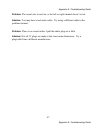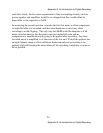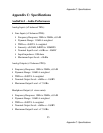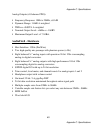
Appendix B: An Introduction to Digital Recording
53
Appendix B: An Introduction to Digital Recording
are matched, any noise added to the minus component will still be approximately
the same as that picked up by the plus component and will be subtracted out by the
input amplifier. Your Echo product uses this type of output.
Balanced signals connect with either XLR connectors or TRS (tip, ring, sleeve)
connectors. Your Echo product uses XLR connectors for microphones and TRS
connectors for connecting balanced (and unbalanced) line level signals.
The three sections of a TRS connector are used to transmit the three components of
a balanced signal (T = plus, R = minus, S = ground).
Dynamic Range
Dynamic range represents the difference between the maximum signal that can be
recorded and the “noise floor”, or level of noise with no signal present. A system
with a high dynamic range will be quieter than one with a lower dynamic range.
Dynamic range is a very important specification, and your echo product uses
converters that have very high dynamic range.
Theoretically, a 24-bit system has a dynamic range of 144dB and a 16-bit system
has a dynamic range of 96dB. Two questions immediately come to mind:
1) Why does my Echo product only have a dynamic range of 110 to 114dB?
2) For mastering 16-bit CDs with a dynamic range of 96dB, isn’t anything
more than 96dB just overkill?
First, today’s analog-to-digital converters typically produce a full-scale input
voltage with an input of +7dBu. If they were to have 144dB of dynamic range, they
would have to be capable of resolving signals as small as –137dBu (7dBu –
144dBu) or approximately 10 nano-volts. That’s 10 one-billionths of a volt!
Transistors and resistors produce noise in this range just by having electrons
moving around due to heat. Even if the converters could be perfectly designed to


















